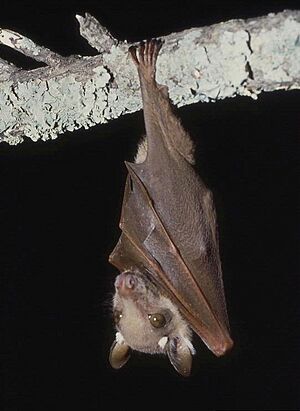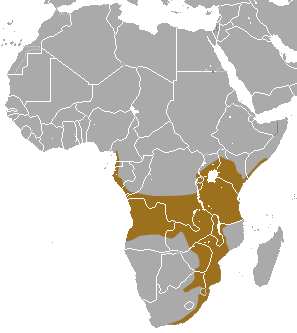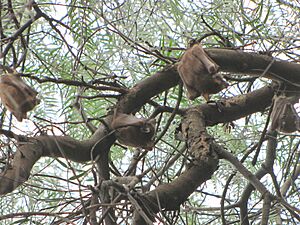Wahlberg's epauletted fruit bat facts for kids
Quick facts for kids Wahlberg's epauletted fruit bat |
|
|---|---|
 |
|
| Conservation status | |
| Scientific classification | |
| Genus: |
Epomophorus
|
| Species: |
wahlbergi
|
 |
|
| Wahlberg's epauletted fruit bat range | |
The Wahlberg's epauletted fruit bat (scientific name: Epomophorus wahlbergi) is a type of large bat. It belongs to a family called Pteropodidae, also known as fruit bats. You can often find this bat flying around in southern Africa.
Contents
About the Wahlberg's Bat
This bat has fur that is brown or light brown. It has white patches of hair right at the bottom of its ears. Male bats are usually a bit darker than females.
Special Features of Males
Male Wahlberg's bats have something unique: special patches of hair on their shoulders called epaulettes. These epaulettes can stand up! They grow around large scent glands, which are like tiny perfume factories. Males also have air sacs on their necks. These sacs help them make louder calls when they are trying to find a mate. Both male and female bats have scent glands near their white ear patches.
Size and Appearance
Compared to other bats, the Wahlberg's fruit bat has wide wings. A grown-up male's wings can stretch from 510 to 600 millimeters (about 20 to 24 inches). Females have slightly smaller wings, from 456 to 540 millimeters (about 18 to 21 inches). These bats usually weigh between 54 and 125 grams (about 2 to 4.4 ounces).
Their eyes are big, which helps them see in the dark. Their ears are simple and oval-shaped, and they don't have a tragus (a small flap inside the ear). Their noses are also simple, but their lips are very folded and can stretch a lot.
How to Tell Them Apart
All bats in the Epomophorus group have white epaulettes, which helps tell them apart from other large bats. The Wahlberg's bat has a special ridge on the roof of its mouth that helps scientists tell it apart from other bats in its own group.
Where They Live and What They Eat
Bat Homes and Habitats
You can find the Wahlberg's epauletted fruit bat all over southern Africa. They live in different places like forests, shrublands (areas with lots of bushes), and savannas (grassy plains with scattered trees). They can live from sea level up to 2,000 meters (about 6,500 feet) high. Sometimes, they even live in city areas with trees or roost inside buildings made by people.
What Do Fruit Bats Eat?
These bats are mainly frugivorous, which means they love to eat fruit! Their favorite foods include figs, guava, and fruits from different Diospyros trees. When they find fruit, they usually carry it away from the tree to another spot. They eat the soft parts of the fruit and then drop the seeds and skins. Sometimes, they might also eat leaves from Balanites trees or even a few insects.
Bat Behavior
Where Bats Rest During the Day

Wahlberg's fruit bats are nocturnal, meaning they are active at night. During the day, they roost (rest) in well-lit, open trees, under palm leaves, or in thick forests near rivers. They might also rest under thatched roofs of sheds, and very rarely, in caves.
They often roost in groups, which can have anywhere from 3 to 100 bats. These bats usually change their roosting spots every day or every few days. They might fly as far as 4 kilometers (2.5 miles) to find good feeding areas. Changing roosts often might help them find ripe fruit or avoid predation (being hunted by other animals). Females tend to fly farther to feeding areas early in the night, while males travel farther closer to dawn. Sometimes, they share roost trees with other types of Epomophorus bats, but each roosting group is made up of only one species.
When they are roosting, their fur patterns help them blend in, which is called camouflage. All Epomophorus bats have white spots on their ears. These spots might help break up the shape of their head when seen from below, making them harder to spot.
How They Fly
Wahlberg's epauletted fruit bats fly relatively slowly. They can sometimes be a bit clumsy, bumping into other bats or obstacles. Before they leave their roost for the night, they spend up to 30 minutes carefully grooming themselves. Most of their flying happens in the first three hours after sunset.
Mating and Reproduction
Outside of breeding and taking care of their young, these bats usually only interact when they are roosting. During the mating season, males leave their roost tree and fly to another tree. There, they make frog-like calls to attract females. They also show off their standing-up epaulettes for up to an hour before moving to a new tree. Calling males stay about 50 meters (175 feet) away from other males. They can make 75 to 120 calls every minute!
These bats have two birth periods each year. The first is from February to March, and the second is from October to December. The first birth period happens when there is a lot of fruit available during the rainy season. Pregnancy lasts about 5 to 6 months. Usually, only one baby bat is born at a time, but sometimes two pups might arrive. Baby bats are typically fully grown by 15 months old. Females can start having babies when they are 12 months old. Males become ready to reproduce a bit later, but before they are 18 months old.
How Their Bodies Work
Body Temperature
The Wahlberg's fruit bat does not go into torpor (a deep sleep to save energy). However, it is heterothermic, meaning its body temperature can change. When it's resting, its body temperature can drop. This change is more noticeable in winter.
Some areas where these bats live have big temperature changes between seasons. To deal with colder winter temperatures, their metabolic rate (how fast their body uses energy) can increase by up to 30% compared to summer. This helps them stay warm. They also gain more body weight in winter. When it's very hot, they might drool a lot, fan their wings, lick their bodies, and pant to cool down. Some bats cannot handle extreme heat and might die if temperatures go above 40 °C (104 °F).


